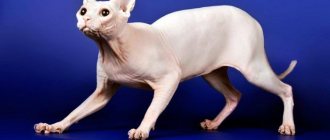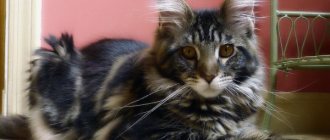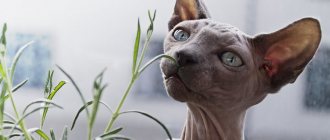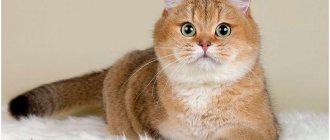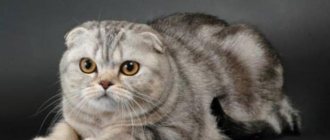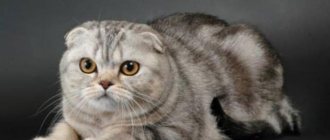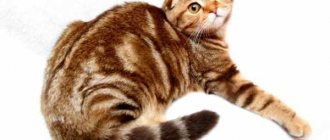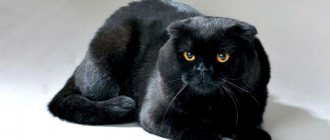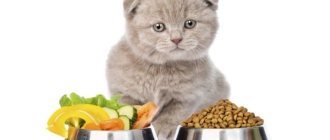Many cat breeds are similar to each other. Some owners don't even know who your pet is. Few people have wondered how the British cat breed differs from the Scottish one. Most often, Scottish owners call their pets “British Fold cat”, and do not even realize that such a breed does not exist!
“British Fold cats” are most often passed off as ordinary Scots, although the shape of the ears is not the only difference between Scottish and British kittens. The result is confusion. However, there are enough differences, and we will try to figure out what they are.
British
This aristocratic cat breed is one of the most ancient. The breeding of purebred Britons began in the 19th century, and the history of the breed began in antiquity, in the Ancient Roman era.
According to the most common belief, this breed originated from gray cats with long, sharp fangs that lived in North Africa and Southern Europe.
These cats were actively domesticated by local residents, and together with Roman legionnaires, representatives of the species that was the ancestor of the British were brought to the British Isles.
These animals were very hardy and quickly transitioned from the hot climate of the Mediterranean to the cool weather of England.
Officially , G. Weier is considered the creator of the breed , who selected similar-looking gray, muscular cats for mating. He was also the first organizer of the exhibition of these animals in 1861.
Differences in appearance
Anyone can recognize representatives of the British breed, even those who are not an expert in cat breeds. The main external differences between cats of this breed:
- the first difference is the regular round shape of the skull, which seems quite wide;
- second difference: all British people have jowls;
- straight, wide, but flattened nose with dimples in the bridge of the nose;
- small, but always straight ears, located at a great distance from each other and quite low;
- the shape of the eyes is close to a perfect circle;
- the most popular eye color among cats of the breed is light brown, almost golden, ocher;
- pure breed representatives do not have a pale rim around the pupil;
- sometimes there are blue eyes;
- The difference between the British is a strong, muscular body structure, a wide back, powerful paws, a strong torso;
- the tail is cone-shaped, strongly tapering towards the tip;
- weight - about 5-6 kg, but some animals reach 7 or more kg;
- According to the type of coat, they are divided into two branches - long-haired and short-haired;
- There are several types of color.
Features of the coat
The fur of a British cat is the pride of the breed. Thanks to the softness and thickness of the fur, the cat becomes like a toy.
The historical homeland of the breed contributed to the creation of luxurious fur. Britain, always covered in fog and watered by endless rains, was the place where the breed was formed even before it became the object of selection.
Due to the damp climate, murkas acquired dense wool, which repelled moisture and allowed the animal to survive on the street, hunt and raise offspring. And insects that bother furry strays contributed to the formation of a thick undercoat.
The length of the hairs is about 2.5 centimeters and remains the same in all parts of the body. For a long time blue was considered the main color, but today there is a whole palette of shades. The presence of ancestors of various breeds also allows one to encounter a variety of “patterns” of cat fur.
British colors
There is a common misconception that the color of British cats must be blue (gray). However, it is not. A specific color does not distinguish a breed from others . Representatives of this breed have quite a lot of color types, and each of them has its own characteristics.
Chocolate
This type of color is considered the rarest. It can be easily distinguished by its uniform coat, which has a rich brown color.
Such kittens are more expensive the darker the brown color of their fur. This color is also called havana or chestnut.
Blue wool color
This shade is the most common among kittens of this breed. Its difference is pure blue, without gray and silver tints as standard. This is also a popular color for the Scots, which is why the question arises of how to distinguish a British cat from a Scottish one. In this case, everyone should remember that the difference between one breed and another is not the color of the coat.
Tortoiseshell
This coloring is also typical for both the British and the Scots. The differences between a British and a Scottish cat of this color are in the depth of color. Among the Scots it is somewhat darker and deeper.
Tortoiseshell coloration is formed during emotional development and is not inherited. Moreover, males of this color are very rare and the color of their coat is the result of a genetic error. Males of the same color cannot give birth to offspring, since they are essentially mutants.
Wang
But this color will help to distinguish between the British Shorthair and Scottish Shorthair cats, because it is found only among the British. The Scottish breed also has a similar color, but it is distinguished by greater precision of lines and depth of the gray part of the color .
Black
Black color is very rare, and therefore its owners are highly valued by cat lovers. It is important that the color is clean, without white hairs and spots - these are considered defective. Both males and females can be black.
These animals have a special eye color - light blue. This is also a valuable feature, since a recessive gene is responsible for it.
White
Very beautiful and also quite rare - white color. These pets look very aristocratic. Moreover, they are somewhat different even from their own relatives. They are more flexible and their status is thinner and more graceful. They are the only ones characterized by light yellow, light green and green eyes - this is the main difference in color.
The most famous cat
Half of her pretty face is red, and the other half is black. Venus's eyes are also multi-colored - green-yellow on the black side, and blue on the red side. For its unusual appearance, the cat was awarded the affectionate nickname “chimera”.
Scots and their differences
Scottish cats are the favorites of many. This breed is distinguished by division into two directions:
- Scottish Straight;
- Scottish fold.
Based on the first type, it is really difficult to determine what the difference is between a British cat and a Scottish one. Their coat color is largely the same, for the most part. The shape of the muzzle is also similar.
The differences between a Scottish cat and a British cat are as follows:
- The Scots have a different body structure: animals of this breed have a more refined skeletal structure, are less squat and not so stocky and big-boned;
- the muzzle remains flattened, but longer than that of the British;
- jowls are less pronounced;
- there are no dimples on the bridge of the nose, what makes them different from the British;
- the Scottish cat breed has a thinner, longer tail;
- The difference between British cats and Scottish cats is also in the shape of their paws: in the former they are shorter, thicker, more massive, and in the latter they are slender;
- there is also a difference in the shape of the head: the Scots have a well-defined chin, and the shape of the skull itself resembles that of a pig;
- There is also a difference in the shape of the ears (if we are talking about the Sconish Fold) - the most remarkable thing. Let us remind you that only Scots can have lop ears, but aristocrats cannot boast of such a detail of appearance - their ears are always pointed.
Chartreuse color
The coat of the Carthusian cat is soft and thick so much that it is comparable to expensive types of fur-bearing animals. The coat has 2 levels: the top, characterized by silkiness and length, and the bottom, a dense and water-repellent undercoat.
The color of the Shertreuse coat can vary from light to darker.
The color of the coat can range from the lightest to the darkest gray. A light tone is a sign of distinction and a higher level of “thoroughbredness.”
Differences in habits and behavior
Differences in appearance are not the only way to recognize representatives of different cat breeds, in our case – British and Scottish. There are also many differences in the behavior of pets. Both have special habits that distinguish one breed from another.
Many cat lovers even choose the breed of their pet not based on external differences, but on character. During the process of evolution, animals developed behavioral habits. The behavior of animals largely depends on the conditions in which their ancestors grew up.
Behavior and sociability
The British are true aristocrats. In games, they prefer to be carried in their arms, but they themselves are reluctant to run after a bow. Their massive body structure is not adapted to fast movement, but they can jump high.
The Scots are a completely different matter. They enjoy spending time with children if they are in the house. They also get along well with other pets, even if there is a dog in the house. The Scots are very active, inquisitive and ready to play with children all day long.
The British, on the contrary, are unsociable and love solitude - this is a difference in their character.
However, they are flexible. If you take your pet in your arms at the moment when he wants to be alone, he will not show aggression and try to escape, and even more so, he will not scratch you. He will endure until you get tired of your pet’s passivity and you leave him alone. In this case, he will rather hasten to hide from the excessive attention of his owners.
Special habits
The Scots have a special habit of standing on their hind legs. One such behavior for a graceful animal is a necessity that has formed over many centuries of development. In this way, your pet stretches its back and puts its vertebrae in order.
Another difference in the behavior of the Scots is “sitting on its butt” : the animal bends one leg and sits on the thigh of the other leg. Their relatives lack these two features.
Relation to height
Even things that for all members of the cat family can distinguish representatives of two related breeds. Strange is the fact that Scots are afraid of heights. These animals very rarely climb high, although academics cannot find a rational explanation for this difference.
British women, on the contrary, love to jump on high cabinets. Their torso allows them to push off the floor strongly and climb high. They usually do this in order to hide from everyone and get a good night's sleep. The difference between British women is their love of silence.
Source
Animal temperament
The Carthusian cat has a calm disposition, low activity at home and high activity outdoors. The pet loves affection, but is not annoying; it prefers to lie in its favorite place for a long time, half asleep.
They treat water calmly. They can coexist with any other animals, as they are not aggressive. Children are loved and not harmed. Chartreux dogs are highly intelligent and quickly get used to the owner’s speech.
Due to their calm nature and patience, Chartreux are excellent ambushers and excellent mousecatchers.
Chartreux loves tranquility

